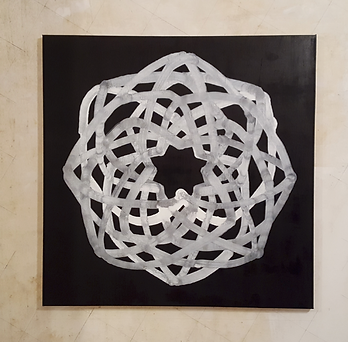Marie Cloquet
TRAVELING LIGHT
08/09/2019 - 20/10/2019
Marc Rossignol
Synchrone
Opening Sunday 9 September 2018
Marc Rossignol
Synchrone
Opening Sunday 9 September 2018
Marc Rossignol
Synchrone
Opening Sunday 9 September 2018
Marc Rossignol
Synchrone
Opening Sunday 9 September 2018
Herman Van Ingelgem
Foreign Bodies & Protheses
06/09/2021 - 17/10/2021
Keiko Sato in The Museum of Modern Art in Arnhem
The pointlessness of war portrayed in collages
Machteld Leij ART (the art magazine in Antwerp), January 2011 Translated into English by Evelien Rose
The subject of artist Keiko Sato (1957, Iwaki City Japan) is a ponderous one. Personal matters and history coincide in her search for the past. For Sato was in New York in 2001, at the time the airplanes flew into the WTC towers. Instantly she thought of her own father who was a kamikaze pilot during the Second World War. He survived. On that fatal day in September the crude realization surfaced that she hardly knew anything about his experiences. So Sato undertook her own journey of exploration, resulting in a book named: “How to tell a story of my father”. The project, consisting of collages and interviews, is the core of her compact exhibition on a narrow gallery in the Museum of Modern Art in Arnhem. There, Sato knows how to keep the appalling pointlessness of war, death and decay in control in stylized collages Sato is mainly known for her large room filling installations, full of broken bricks or pieces of glass. They express melancholy, and evoke a sense of destruction.
The artist started painting in the early eighties, attended the Goldsmith’s College of Fine Art in London and in the early nineties the Jan van Eyck Academy in Maastricht. Presently she lives in Nijmegen.
For the work ‘Berlin Wall 2006-2010 she collected images, stories and quotations by Bertolt Brecht and others. She also recorded her own, somewhat trivial memories of her stay in the city in 1987 and 1993. She felt ignorant and lonely then. The anecdotes about the war are more poignant. How for example the passageways below the underground station Gesundbrunnen served as an air-raid shelter, until there was not enough air left anymore and everybody had to get out again, whether there were bombardments or not. The fragment originates from the book: ‘Berlin, the downfall, 1945’ by Antony Beevor.
Neat
In a certain way Sato’s collages are neat. Pieces of cardboard are photocopied. The visual effect is that all rough sordidness that belongs to collages, is neatly brushed away. And then it dawns on you: her occasionally almost graphic approach works as a soothing blanket preventing the art to scream the stereotypes of war, death and violence but telling it in a more subtle way. Sometimes, whispering is better than shouting in order to be heard. Another collage consists of gruesome images of victims of the Second World War: a heartbreaking scene of a father who buried a tricycle together with his deceased three years old son. He played outside when the bomb fell on Hiroshima. Diminutively written words surround the images. Cut out cries, and sounds crawl as padding around the photographs, as if to reduce the distress.
At one time Sato worked as a midwife but wanted to start painting. The artist Kaoru Yukoi was the initiator of the artist group called Wind, which Sato joined in 1981. Yukoi was politically active in the student movement in the fifties and sixties and with a fresh memory of the atrocities of the war, he protested against the Japanese authorities. The politically committed art of Yukoi’s generation opened her eyes. Being an artist, at first she just wanted to paint, but finally she realized that art cannot be separated from political and social matters. Politics are personal, the feminists already declared. This adagio is easily applicable to the work of Sato in her search of understanding how war influences and deforms people. It is her willingness to include other peoples’ lives and histories in her work that makes the raw emotions be left behind to be replaced by understanding and maybe even insight. A particularly impressive effect of this small presentation in Arnhem.
.png)
.png)
